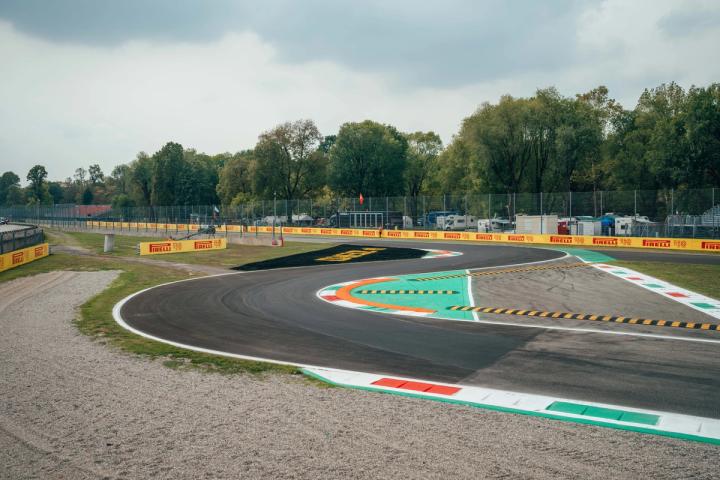Formula 1 visits one of the all-time great tracks on the calendar for the Italian Grand Prix this weekend, as Monza hosts Round 14 of the 2023 season.
Low-downforce setups and maximum horsepower will see F1's 20 cars racing at some of the fastest speeds this year around 3.6 miles of pure motorsport magnificence.
You're probably familiar with the track's steep banking from its history and the connections to a certain red rival of ours, but here are five things you might not already know about Monza and the Italian Grand Prix.
Fine Margins
The closest F1 finish in history could be at Monza's 1973 Italian GP when BRM's Peter Gethin pipped March's Ronnie Peterson to the win by 0.01 seconds in a frenetic ending to a flat-out 55-lap fight.
Timings down to three decimal places weren't part of the sport until the 1980s, so the controversial 2002 US Grand Prix, when Rubens Barrichello beat Michael Schumacher by 0.011s, might be closer than Gethin's triumph, but we'll never know.
However, what we do know is that no race has had the lead five cars finish tighter than that 1973 epic — the top five crossed the line with just 0.61s covering them, with Chris Amon some 32 seconds adrift in P6.
Wear the W
F1 at its fastest
That 1973 race also held an all-time F1 record for the quickest grand prix without a red flag for 40 years — before Schumacher rewrote the history books.
Gethin's race time of 1:18:12.60 looks relatively pedestrian compared to the 1:14:19.838 Schumacher achieved in the 2003 Italian Grand Prix when he beat Juan Pablo Montoya's FW25 to victory by 5 seconds.
Italy doesn't hold the record for the shortest-ever race, though, thanks to the one-lap 2021 Belgian GP coming in at just 3:27.071s after red flags ended a soaking Sunday at Spa Francorchamps.
Top Speeds at the Temple
Goodwood might host the Festival of Speed, and Assen may claim the Cathedral of Speed title, but Monza's nickname of the Temple of Speed is perhaps the most apt moniker of them all.
This power-hungry circuit has drivers going full throttle for over 75% of any lap, and drivers regularly reach 340km/h or faster as they hurtle down to Turn 1.
Mexico's thin air and long pit straight may see the highest speed trap recordings. But Monza's nearly non-stop nature means a driver's average speed over one lap is around 250km/h — approximately 50km/h faster than a lap of Mexico City's Autódromo Hermanos Rodríguez.
Monza's 11 corners, bordered by iconic red, white and green kerbs, are all that break up a high-throttle lap.
A Peaceful Park
While the motorsport world will know Monza for its status as a legendary race track, many Milan locals view its grounds as a serene spot to escape the city.
When the Parco di Monza doesn't have cars hurtling around at breakneck speeds, it serves the city as a 688-hectare walled park — the largest of its kind in Europe — for residents to enjoy.
Monza Circuit, or Autodromo Nazionale Monza, has lived in the park since 1922, but its grounds first opened to the public over 100 years earlier. During his time as viceroy of Italy, Eugène de Beauharnais, Napoleon's stepson, commissioned the park in 1808.
Quickest Qualifying
Lewis Hamilton's 2020 pole position lap is F1's fastest in a competitive session when he covered the 5.793 km circuit in just 1:18.887 to record an average speed of 264.362 km/h (or 164.267 mph).
His scintillating time shows how quick the previous generation of cars were, with Kimi Raikkonnen's 2018 effort (1:19.119 or 263.59 km/h) breaking a 15 year-old record held by the early 00s rockets, the sport’s previous one-lap wonders.
Juan Pablo Montoya's 2002 pole position in the FW24 with a 1:20.264 (at 259.83 km/h) appeared an insurmountable benchmark effort for much of the modern era as the FIA introduced various rules to limit F1's speeds for safety.
This year’s quali will see the second running of the ‘Alternative Tyre Allocation’ qualifying trial.
Having been run in Hungary, we’ll see the ATA again at Monza as F1 continues its journey towards sustainability. If you need a quick refresher, each team will each receive fewer dry tyre sets than usual – 11 down from 13.
In Q1, drivers must run the hard compound, with those making it through to Q2 then competing on the medium. Q3 will see the final 10 drivers all qualify on the soft compound.
Emilia Romagna 2024
Pit Wall Predictions
Related Tags:
Powered By
© the Williams Group, under licence to Williams IP Holdings LLC
Williams Grand Prix Engineering Limited is a company registered in England and Wales under company number 1297497.
Its registered office is at Grove, Wantage, Oxfordshire, OX12 0DQ
Powered By






